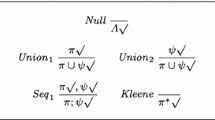Abstract
The behavior of an agent is mainly governed by the specific way in which it handles the rational balance between information and deliberation. Rao and Georgeff's BDI theory is most popular among the formalisms capturing this very balance. This formalism has been proposed as a language for specifying agents in an abstract manner or, alternatively, for verifying various properties of agents implemented in some other programming language. In mainstream computer science, there are formalisms designed for a purpose similar to the BDI theory; not specifically aiming at agents, but at concurrency in general. These formalisms are known as logics of concurrent programs. In this paper these two frameworks are compared with each other for the first time. The result shows that the basic BDI theory, BDICTL*, can be captured within a standard logic of concurrency. The logic which is relevant here is Kozen's propositional μ-calculus. μ-calculus turns out to be even strictly stronger in expressive power than BDICTL* while enjoying a computational complexity which is not higher than that of BDCTL*'s small fragment CTL. This correspondence puts us in a position to provide the first axiomatization of Rao and Georgeff's full theory. Immediate consequences for the computational complexity of BDI theory are also explored, both for theorem proving and model checking.
Similar content being viewed by others
References
M. Benerecetti, F. Giunchiglia, and L. Serafini, “A model checking algorithm for multiagent systems”, in Intelligent Agents V.Proc.Fifth Int.Workshop on Agent Theories, Architectures, and Languages (ATAL-98), 1999, pp. 163–176.
M. E. Bratman. Intentions, Plans, and Practical Reason. Harvard University Press: Cambridge, MA, 1987.
R. Bull and K. Segerberg, “Basic modal logic”, in Handbook of Philosophical Logic, vol. 2, Reidel: Dordrecht, The Netherlands, 1984, pp. 1–88.
L. Catach, “Normal multimodal logics”, in Proc.7th Nat.Conf.American Association for Artificial Intelligence, 1988, pp. 491–495.
E.M. Clarke and E. A. Emerson, “Design and synthesis of synchronization skeletons using branching time temporal logic”, in Proc.Workshop on Logics of Programs, Lecture Notes in Computer Science, vol. 131, Springer-Verlag: New York, 1981, pp. 52–71.
R. Cleaveland and B. Steffen, “A linear-time model-checking algorithm for the alternation-free mu-calculus”, in Proc.3rd Int.Workshop on Computer Aided Verification, 1991, pp. 48–58.
P. R. Cohen and H. J. Levesque, “Intention is choice with commitment”,. Artif.Intell. vol. 42, pp. 213–261, 1990.
E. A. Emerson, C. S. Jutla, and A. P. Sistla, “On model-checking for fragments of mu-calculus”, in Computer Aided Verification: Proc.5th Int.Conf.CAV'93, 1993, pp. 395–396.
E. A. Emerson, “Temporal and modal logic”, in Handbook of Theoretical Computer Science, vol. B, Elsevier: Amsterdam, The Netherlands, 1990, pp. 995–1072.
E. A. Emerson and J. Y. Halpern, “`Sometimes' and `not never' revisited: on branching versus linear time temporal logics”,. J.ACM vol. 33(1), pp. 151–178, 1986.
E. A. Emerson and C. S. Jutla, “The complexity of tree automata and logics of programs (extended abstract)”, in Proc.29th Annu.Symp.on Foundations of Computer Science, 1988, pp. 328–337.
R. Fagin, J. Y. Halpern, Y. Moses, and M. Y. Vardi, Reasoning About Knowledge, MIT Press: Cambridge, MA, 1995.
M. J. Fischer and R. E. Ladner, “Propositional dynamic logic of regular programs”,. J.Comput.Syst. Sci. vol. 18, pp. 194–211, 1979.
J. Y. Halpern and Y. Moses, “A guide to completeness and complexity for modal logics of knowledge and belief”,. Artif.Intell. vol. 54, pp. 319–379, 1992.
D. Harel, “Recurring dominoes: Making the highly undecidable highly understandable”, in Topics in the Theory of Computation: Selected Papers of the International Conference on Foundations of Computation Theory, 1983, pp. 51–71.
D. Harel, “Dynamic logic”, in Handbook of Philosophical Logic, vol. 2, Reidel: Dordrecht, The Netherlands, 1984, pp. 497–604.
J. Hintikka, “Semantics for propositional attitudes”, in Models for Modalities, Reidel: Dordrecht, The Netherlands, 1969.
D. Kozen, “Results on the propositional μ-calculus”,. Theor.Comput.Sci.vol. 27, pp. 333–354, 1983.
D. Kozen and J. Tiuryn, “Logics of programs”, in Handbook of Theoretical Computer Science, vol. B, Elsevier: Amsterdam, The Netherlands, 1990, pp. 789–840.
S. A. Kripke. “Semantical analysis of modal logic I: Normal propositional calculi”,. Zeitschrift f¨ur mathematische Logik und Grundlagen der Mathematik, 1963, pp. 67–96.
V. R. Pratt, “Semantical considerations on Floyd-Hoare logic”, in Proc.17th IEEE Symp.on Foundations of Computer Science, 1976, pp. 109–121.
V. R. Pratt, “A decidable mu-calculus: Preliminary report”, in Proc.22nd Annu.Symp.on Foundations of Computer Science, 1981, pp. 421–427.
A. S. Rao and M. P. Georgeff, “Modeling rational agents within a BDI-architecture”, in Proc.2nd Int.Conf.on Principles of Knowledge Representation and Reasoning, 1991, pp. 473–484.
A. S. Rao and M. P. Georgeff, “A model-theoretic approach to the verification of situated reasoning systems”, in Proc.13th Int.Joint Conf.on Artificial Intelligence, 1993, pp. 318–324.
A. S. Rao and M. P. Georgeff, “Formal models and decision procedures for multi-agent systems”, Australian AI Institute, Level 6, 171 La Trobe Street, Melbourne, Australia, Technical Note 61, 1995.
S. Safra, “On the complexity of !-automata”, in Proc.29th Annu.Symp.on Foundations of Computer Science, 1988, pp. 319–327.
K. Schild, “On the relationship between BDI logics and standard logics of concurrency”, in Intelligent Agents V.Proc.Fifth Int.Workshop on Agent Theories, Architectures, and Languages (ATAL-98), 1999, pp. 47–61.
R. S. Streett, “Fixpoints and program looping: Reductions from the propositional mu-calculus into propositional dynamic logics of looping”, in Proc.13th ACM Symp.on Theory of Computing, 1981, pp. 375–383.
A. Tarski, “A lattice-theoretical fixpoint theorem and its applications”,. Pacific J.Math.vol. 5, pp. 285–309, 1955.
I. Walukiewicz, “On completeness of the μ-calculus”, in Proc.8th Annu.IEEE Symp.on Logic in Computer Science, 1993, pp. 136–146.
M. Wooldridge, “Agent-based software engineering”,. IEEE Proc.Software Eng.vol. 114(1), pp. 26–37, 1997.
Author information
Authors and Affiliations
Rights and permissions
About this article
Cite this article
Schild, K. On the Relationship Between BDI Logics and Standard Logics of Concurrency. Autonomous Agents and Multi-Agent Systems 3, 259–283 (2000). https://doi.org/10.1023/A:1010076027707
Issue Date:
DOI: https://doi.org/10.1023/A:1010076027707




